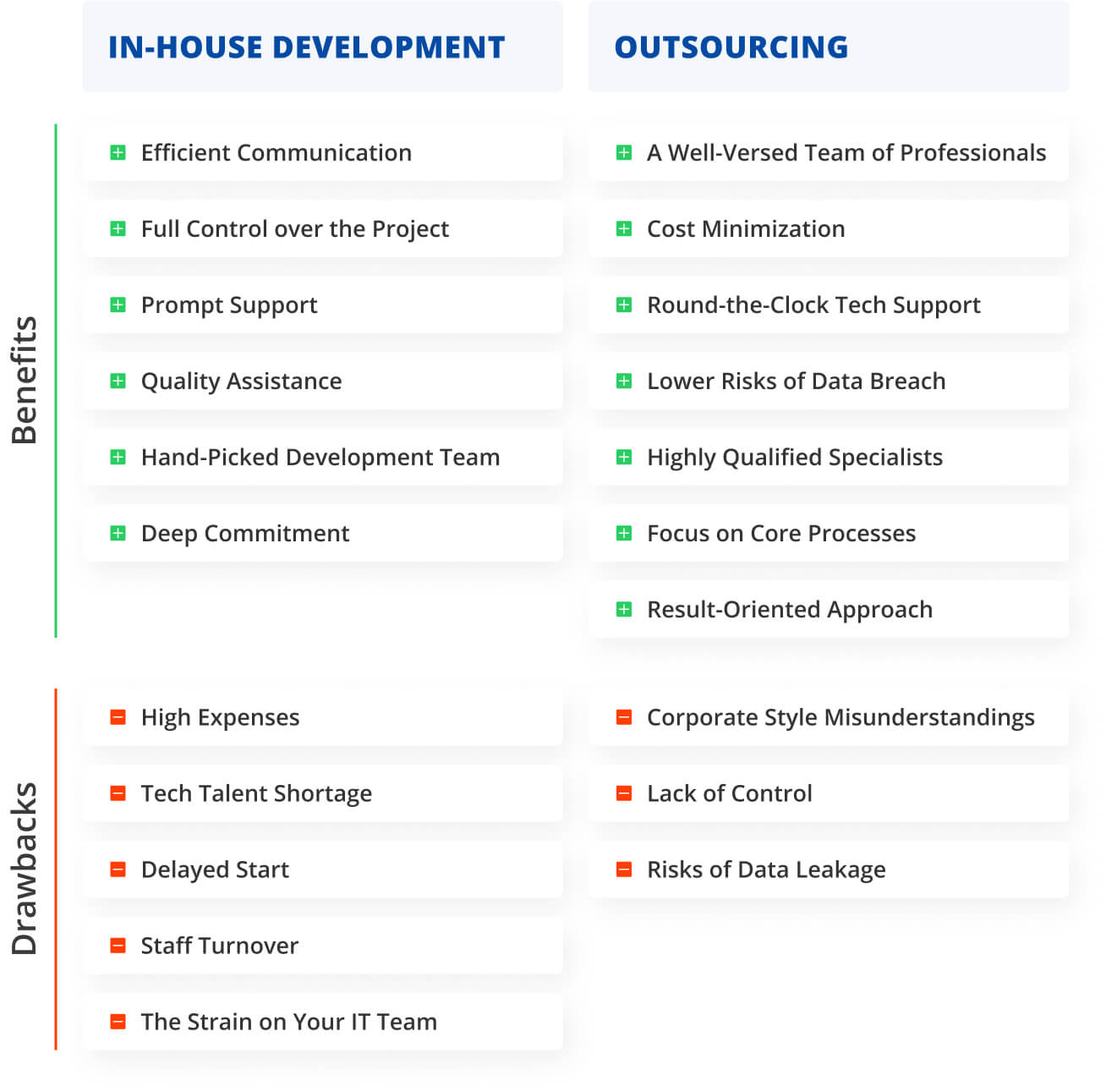In today’s frenzied world market growth, companies are repeatedly faced with the dilemma: in-house software development vs. outsourcing their projects to a third-party service provider. This decision has a significant impact on the further success and growth of a company, making it crucial to thoroughly evaluate the benefits and drawbacks of each approach. In this article, we will examine the aspects to consider when choosing between in-house vs. outsourced software development and provide guidance on making an informed choice.
The Rise of IT Outsourcing Worldwide
More and more companies over the globe opt for hiring specialists for each single project rather than handling a corresponding team in the company. The outsourcing market is growing by leaps and bounds, with IT services comprising 72% of outsourcing contracts and generating $66.5 billion out of the $92.5 billion spent on outsourcing in total. The market of IT outsourcing is in full swing which is backed up by Statista forecasts – it predicts an annual growth rate of 11.07%, resulting in a market volume of US$777.70bn by 2028.

Source: statista.com
Outsourcing VS In-House Development
Some companies tend to build IT products on their own with in-house development, while others turn to outsourcing and take advantage of the expertise of IT service providers. Both of these approaches have their own advantages and disadvantages. So let us look at them more closely and try to determine which approach is most efficient.
In-House Development: Benefits
Relying on a business’s internal resources can have its benefits. Let’s look at them:
Efficient Communication
Your development team is aware of what’s going on and has already touched base with each other. This has a favorable impact on the quality and speed of the project: they know the company’s aims and vision, they can collaborate well, and don’t need repeated explanations of the project’s requirements.
Full Control over the Project
In-house development provides an opportunity to have complete control over the development process. Since your internal team members are on your payroll, you can use the workforce efficiently. Employees can be taught the corresponding technologies, methodologies, and philosophies to pursue the direction required.
Prompt Support
Your in-house team can be solely focused on a particular project/task and can provide prompt support. Well-trained staff will be prepared for non-standard projects and find solutions faster.
Quality Assistance
An internal team can update and manage both software and local hardware. Since this team can communicate with all business departments, they understand business processes at a deeper level, which leads to working out possible problems more accurately and efficiently.
Hand-Picked Development Team
When hiring full-time specialists, you have the possibility to handpick the talents with aligned competencies your company needs. You know each person is qualified for a specific position and performs a designated role. When you outsource development, you have no idea who is on the team or what their qualifications are.
Deep Commitment
With a team of employees working exclusively on your company’s projects, you develop a sense of commitment that positively affects the team’s productivity and product quality. One shouldn’t overlook this emotional aspect, as it may play no less significant role in the project.

“Looking to scale and improve your software development? We are happy to help”.
In-House Development: Drawbacks
While there are a bunch of benefits to developing your own software internally, there are some tangible drawbacks that put off a number of companies:
High Expenses
Hiring an excellent internal team is costly for an employer. According to Glassdoor, it costs $4,000 and 24 days for an average U.S. employer to hire a new worker. Additionally, an employer has to pay salaries, which are on average $105K per year for U.S. developers. When the team isn’t involved in any project, you’ll still have to cover their fixed salaries.
Tech Talent Shortage
Skilled professionals aren’t waiting for you on the job market, as other companies quickly hire them. It always takes a while to find a good one that would meet your requirements and business philosophies. Looking for a specialist can become a burdensome, time- and effort-consuming task, which may ultimately not pay off.
Delayed Start
Any project requires a particular set of skills. If any of them is missing, a new worker must be sought to close the gap. This delays the project start and negatively affects team productivity on the whole. In addition to it, other ongoing projects that your employees are involved in may slow down the project’s completion.
Staff Turnover
We shouldn’t overlook the phenomenon of employee churn. Some workers stay, but the reality proves that most workers come and go, since the market is always in search of vetted specialists. And each time, it costs tangible time and money for a new employee to adjust to the company, accrue experience, and touch base with colleagues.
The Strain on Your IT Team
Let’s say you hired a strong team of developers to handle the business processes. Then you add up to their workload a new project of utmost importance. As a result, your IT team has to switch focus from one task to another and in case of arising problems, some work may not be done as thoroughly as it could be.
Outsourcing: Benefits
Outsourcing your project to an IT service provider can bring you substantial benefits. Among the most significant advantages, we can single out the following ones:
A Well-Versed Team of Professionals
The outsourcing company has to retain an edge in a highly competitive IT market. In turn, competition requires improving all internal processes: development, team management, and quality assurance. In this environment, an outsourced team can quickly assemble and dive into new subject areas.
Cost Minimization
Around two-thirds of employers name cost savings as a key advantage of outsourcing. The profitability of outsourcing depends on many factors. For one thing, you don’t have to pay full salary and annual bonuses to your employees, open a whole IT department on-site or invest in costly equipment.
Round-the-Clock Tech Support
Companies generally run from 9 to 6, so your regular employees will not provide customer support beyond this time without additional payment. In contrast, hiring an external team will let you choose 24/7 support to be available without overtime pay.
Lower Risks of Data Breach
In an increasingly competitive environment, outsourcing companies seek to provide better and more secure services. Therefore, they are taking measures to improve data recovery and prevent data loss and technological downtime.
Highly Qualified Specialists
With outsourcing, you can select specialists tailored to the needs of the project. Such companies have a wide range of professionals specially trained to perform a specific set of tasks, so project managers hire people with a specific set of skills for each project.
Additionally, the outsourcer has experience in implementing products for different industries and thus can help the company decide flexible solutions and launch software on time.
Industries We Serve

Focus on Core Processes
Delegating a project to a service provider frees up your workforce and allows it to focus on other important tasks and manage workflow tech-wise. This will thereby favorably affect the project results, since building a quality future-proof product for an outsourced team is an utmost priority.
Result-Oriented Approach
A full-time employee at work can simply idle between projects, covering the bare minimum. An outsourced engineer, in contrast, receives a fee only for a specific result required by the company. This ensures an efficient and quality-centered approach that will help build a better product within narrower time limits.
Outsourcing: Drawbacks
Despite a plethora of benefits outsourcing offers, there are a couple of aspects to watch out for:
Corporate Style Misunderstandings
By all criteria, the contractor performs the work correctly, aligning with the requirements and quality standards. However, the business specifics and philosophy often pose nuances that need to be clearly clarified from the outset. Otherwise, it can delay the product launch and lead to additional costs.
Lack of Control
When having an outsourced team working on your future product, you don’t get complete control over delegated business processes. Since tasks are handled by non-staff personnel, it is pretty challenging to have transparent supervision of their implementation. The solution is to find a reliable partner with detailed reports and the possibility to make adjustments at each project stage.
Risks of Data Leakage
Privacy is the key problem of modern society. To minimize the risks related to the illegal use of confidential information or the possible transfer of it to third parties, it is crucial to carefully specify in the contract the rights and obligations of the company regarding the disclosure of information.
Tips for Outsourcing with Highest Efficiency
This model can help you reap tangible tech and financial benefits if carried out properly. Here are some tips on how to outsource your projects the right way:
Outsource The Right Tasks
A reckless choice of the services to be delegated is a bad choice. Make a well-considered decision and outsource those processes that drain your staff most and hinder business performance.
Define Your Goals
Before starting the journey, make sure you know the ultimate aim of the project, be it an increase in security, ROI, or cost savings. Once you outline the goals for yourself, you will be able to clarify them to the outsourced team and set a solid foundation for the product you want.
Choose Wisely
There are much praiseworthy IT service providers on the market. Still, it doesn’t cancel out the existence of companies with poor reputation. Take a close look at all the aspects: portfolio, reviews, certification, etc. A thorough study is bound to help you find the right partner in line with your expectations.
Outsourcing That Works: A Few Examples…
Summary: Which Model to Choose?
As you can see from the brief summary below, each of the mentioned development models has both advantages and disadvantages:

So let’s sum up all the points before you choose one of them. There are a number of factors affecting the final choice:
Company’s Size
It’s difficult for small businesses to compete for outstanding employees, while quick product development is critical at this stage. This indicates that it is better for small firms not to spend time on the lengthy recruitment process and outsource first projects for a quick quality start. Having said that, it would be nice to find some people to help direct and control the product implementation process.
Timeframes
The recruitment process is lengthy, so if you need to hire people quickly to keep up with the tight release dates of the product, outsourcing is the best option because it takes much less time. However, if you need a long-term employee, hiring a full-time worker will be more profitable.
Project Terms
It is wiser to outsource short-term projects to reduce expenses. Meanwhile, long-term projects that require regular and consistent work are better to be the focus of your internal team.
To Draw the Line
Each business must make its own decision on how to properly distribute the workforce. Yet, the ever-growing popularity of staff outsourcing leads to the conclusion that it tangibly outweighs in-house development by the benefits it offers. If you consider in detail the outlined drawbacks of outsourcing, you’ll see the takeaway – it’s possible to dodge possible risks if you choose your partner and draft a contract carefully.



















